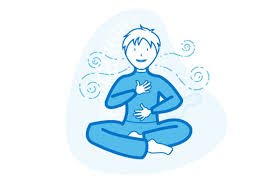Deep Breathing
Deep breathing is a simple yet powerful technique that can significantly benefit individuals with fat disorders, such as Dercum’s Disease or Lipedema. The practice not only helps in improving lymphatic flow but also reduces stress, which can exacerbate symptoms. Here’s a detailed look at how deep breathing can be beneficial:

Benefits of Deep Breathing for Fat Disorders
Enhancing Lymphatic Circulation:
The lymphatic system relies on muscle movement and breathing to circulate lymph fluid throughout the body. Deep breathing creates pressure changes in the chest cavity, acting as a pump that stimulates lymphatic flow. This can help reduce swelling, inflammation, and fluid retention often associated with fat disorders.Reducing Stress and Pain:
Deep breathing activates the body’s parasympathetic nervous system, which promotes relaxation and reduces stress. Chronic stress can worsen the symptoms of fat disorders, such as increasing inflammation and pain. By practicing deep breathing, patients can manage stress levels and experience a calming effect on the body.Improving Oxygen Flow:
Proper oxygenation of the body is crucial for tissue health and healing. Deep breathing increases oxygen intake, which can improve cellular function, support detoxification, and aid in overall physical well-being.
How to Practice Deep Breathing
Here’s a simple guide to practicing deep breathing to promote lymphatic health and relaxation:
Find a Comfortable Position:
Sit or lie down in a comfortable, quiet place. Ensure your back is straight, shoulders are relaxed, and your body is free from tension.Inhale Slowly:
- Place one hand on your abdomen and the other on your chest.
- Breathe in slowly through your nose for about 4-6 seconds, feeling your abdomen expand as your lungs fill with air. The hand on your abdomen should rise more than the hand on your chest.
Hold the Breath:
- Hold your breath gently for 2-3 seconds. This helps maximize oxygen absorption and promotes lymphatic circulation.
Exhale Slowly:
- Breathe out slowly and completely through your mouth for 4-8 seconds, allowing your abdomen to fall inward. This exhalation helps expel toxins and stagnant fluids.
Repeat:
- Continue this cycle of deep breathing for 5-10 minutes. Focus on your breath and the rise and fall of your abdomen.
Frequency:
- Practice deep breathing 2-3 times a day or whenever you feel stressed or need to enhance lymphatic circulation.
Tips for Effective Deep Breathing
- Incorporate with Meditation: Pair deep breathing with meditation or mindfulness exercises to further reduce stress and support emotional well-being.
- Combine with Movement: For added benefits, practice deep breathing while doing gentle stretching, yoga, or Manual Lymphatic Drainage (MLD).
- Consistency: Regular practice is key. The more frequently you engage in deep breathing, the more effectively it can help manage symptoms of fat disorders.
